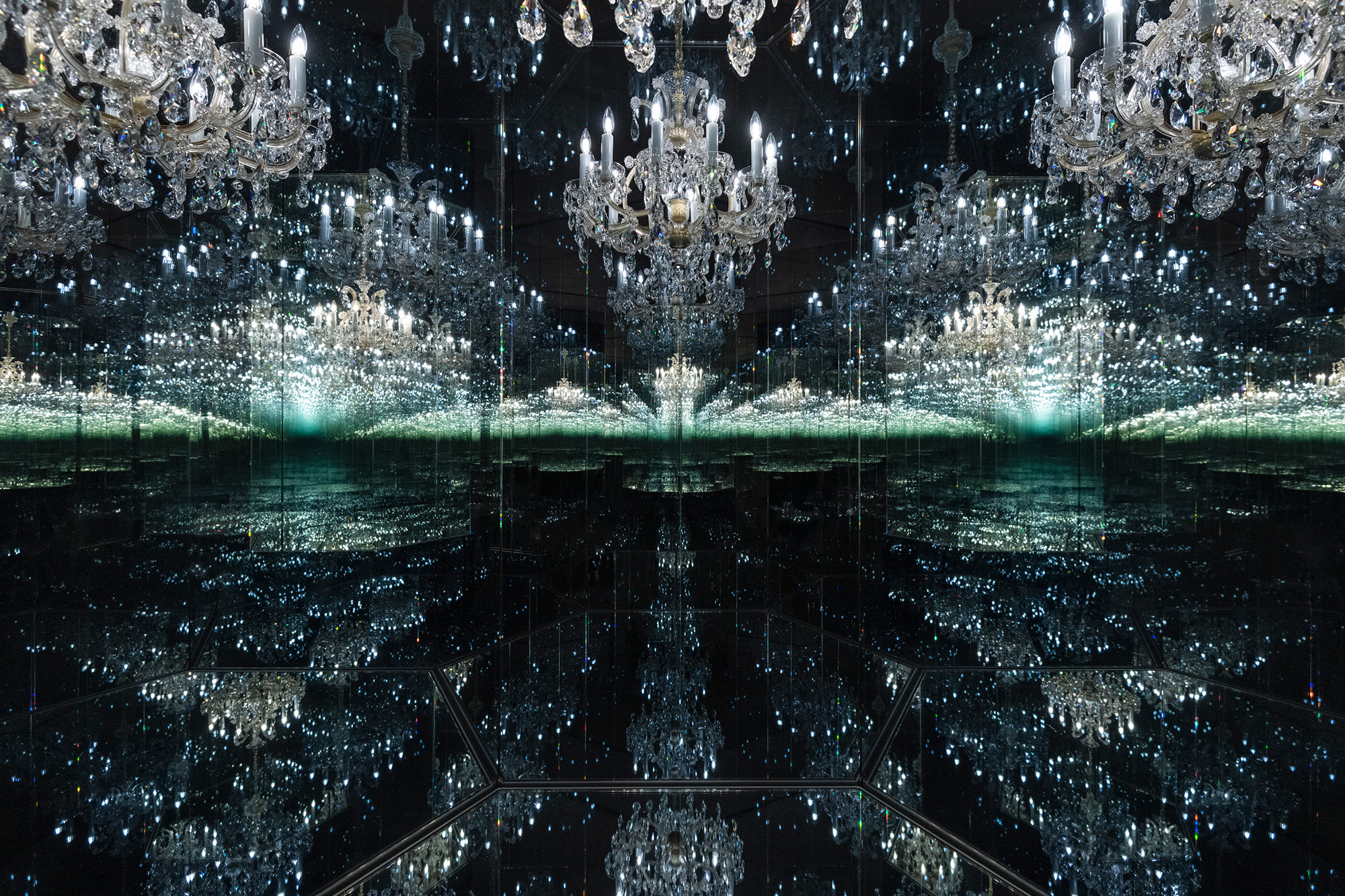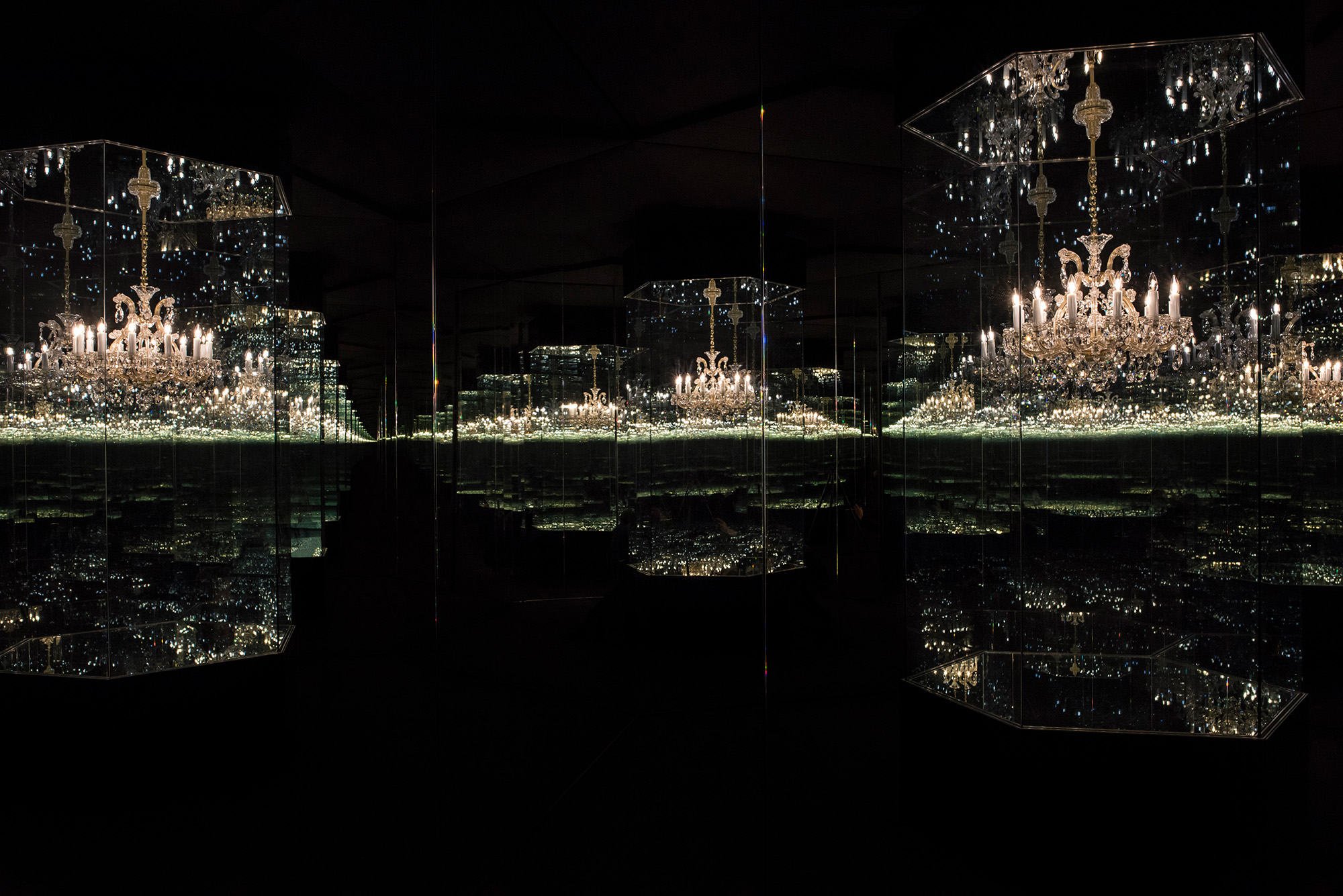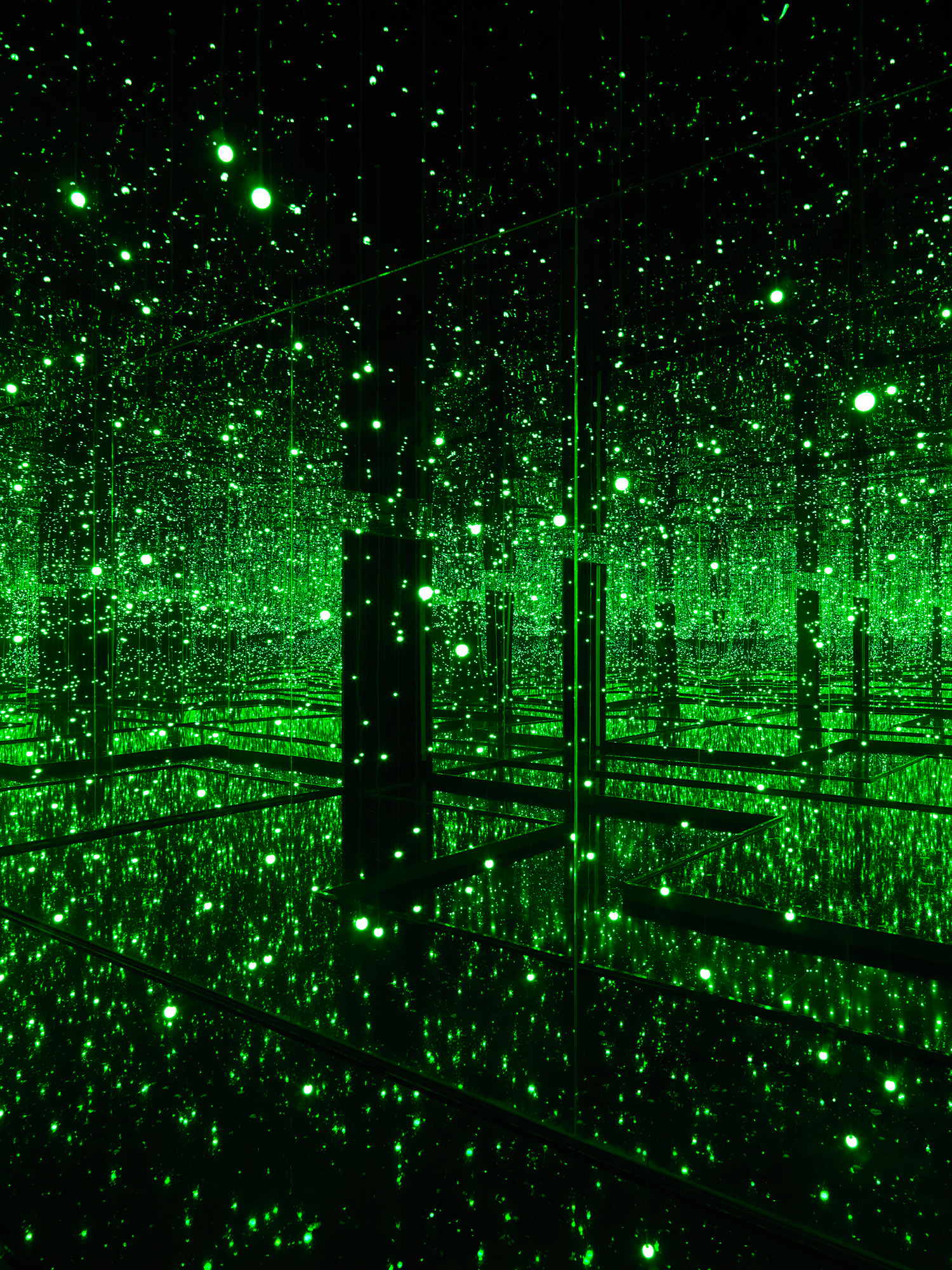Space is not what it seems, Yayoi Kusama at Tate Modern
An installation of two of Yayoi Kusama’s celebrated infinity rooms at Tate Modern provide relentless depth and disorientating geometries. The way it is installed breaks the fourth wall, emphasising the tricks of the artist.
The mystery of a vast other world contained within some a
smaller geometry in our own realm frequently pops up in fiction. Think of Narnia
concealed within a cupboard, or the enormity of the TARDIS compared to its
external frame, or Alice clambering into a hole and discovering Wonderland.
It’s a beguiling trick, and one also played at Tate Modern with their installation of two of Yayoi Kusama’s infinity rooms, those spaces of infinite vision and disorientating geometry. When a Kusama room is often exhibited it is entered through a door or opening in a white gallery wall, a simple dark rectangle inviting deeper exploration behind and not knowing what is the other side of that wall.
![]()
Here at Tate, the two rooms sit as freestanding installations in the open-plan gallery space. The opening is still inviting, but standing outside the entrance one can see the totality of the room, the reality of its size. And so it is that when a visitor enters, they take with them the knowledge of the architecture they have entered, so when faced with the repeating depths of the mirrored interior, there’s a knowing juxtaposition at play which is less resonant when one simply walks through a black hole in a long gallery wall.
It can work two ways. It can work to increase the surprise and emphasise the spatial play, but it may also disappoint some visitors to break that fourth wall and see just how small the structures look externally. Tate have two of the rooms, and when standing in their vast Blavatnik Building gallery they look a little whimsical and underwhelming. There are other wall works around the space which help to add some contextual content, but it’s evident from queues that most people are here for the Instagrammable rooms.
![]()
![]()
![]()
The first room, Chandelier of Grief (2016/2018), is a hexagonal room with a hexagonal vitrine at its centre. The face of all the outer walls are mirror, while contained within that central housing is a single chandelier, rotating and flickering in the light – the dancing light reflecting around and appearing as dissipating stars in the surrounding infinite darkness. It’s a phenomenological space which invites a psychological introspection, if it weren’t for visitors jostling for angles to capture the impossible selfie with no other person in.
The second infinity room is Infinity Mirrored Room – Filled with the Brilliance of Life (2011/2017). In this interior there is a path to follow through shallow water. In the darkness, with the attraction of ever-distant dots, and the distraction of having to relentlessly photograph the experience, it’s inevitable that people occasionally step into the water. But it isn’t deep, not that you would know that to look at it as it too has the sense of endlessness present in the walls and ceiling. In this space there is not just one light, but hundreds of small LEDs which hang from the ceiling and slowly shift through colours.
![]()
![]()
![]()
The room is designed to unnerve, to offer you enough geometry to settle your bodily position within the world created, but then enough unreliability and change to stop you ever quite knowing the truth. It is also impossible to ever shake off your own self within the space, repeated alongside the lights until you can see yourself no more, continuing in reflected reality far deeper than your eye can see and mind can imagine.
All too quickly you will be forced out of the space, reminded it was in fact finite after all, and find yourself back in the whiteness of the main gallery space. Looking back, you see again how small it is externally, and even if the forewarning of the scale of the space stopped you believing the imagined depths, still a curiosity that just for a moment, space was not what it seemed.
![]()
![]()
figs.ix,x
It’s a beguiling trick, and one also played at Tate Modern with their installation of two of Yayoi Kusama’s infinity rooms, those spaces of infinite vision and disorientating geometry. When a Kusama room is often exhibited it is entered through a door or opening in a white gallery wall, a simple dark rectangle inviting deeper exploration behind and not knowing what is the other side of that wall.

fig.i
Here at Tate, the two rooms sit as freestanding installations in the open-plan gallery space. The opening is still inviting, but standing outside the entrance one can see the totality of the room, the reality of its size. And so it is that when a visitor enters, they take with them the knowledge of the architecture they have entered, so when faced with the repeating depths of the mirrored interior, there’s a knowing juxtaposition at play which is less resonant when one simply walks through a black hole in a long gallery wall.
It can work two ways. It can work to increase the surprise and emphasise the spatial play, but it may also disappoint some visitors to break that fourth wall and see just how small the structures look externally. Tate have two of the rooms, and when standing in their vast Blavatnik Building gallery they look a little whimsical and underwhelming. There are other wall works around the space which help to add some contextual content, but it’s evident from queues that most people are here for the Instagrammable rooms.



figs.ii-iv
The first room, Chandelier of Grief (2016/2018), is a hexagonal room with a hexagonal vitrine at its centre. The face of all the outer walls are mirror, while contained within that central housing is a single chandelier, rotating and flickering in the light – the dancing light reflecting around and appearing as dissipating stars in the surrounding infinite darkness. It’s a phenomenological space which invites a psychological introspection, if it weren’t for visitors jostling for angles to capture the impossible selfie with no other person in.
The second infinity room is Infinity Mirrored Room – Filled with the Brilliance of Life (2011/2017). In this interior there is a path to follow through shallow water. In the darkness, with the attraction of ever-distant dots, and the distraction of having to relentlessly photograph the experience, it’s inevitable that people occasionally step into the water. But it isn’t deep, not that you would know that to look at it as it too has the sense of endlessness present in the walls and ceiling. In this space there is not just one light, but hundreds of small LEDs which hang from the ceiling and slowly shift through colours.



figs.v-viii
The room is designed to unnerve, to offer you enough geometry to settle your bodily position within the world created, but then enough unreliability and change to stop you ever quite knowing the truth. It is also impossible to ever shake off your own self within the space, repeated alongside the lights until you can see yourself no more, continuing in reflected reality far deeper than your eye can see and mind can imagine.
All too quickly you will be forced out of the space, reminded it was in fact finite after all, and find yourself back in the whiteness of the main gallery space. Looking back, you see again how small it is externally, and even if the forewarning of the scale of the space stopped you believing the imagined depths, still a curiosity that just for a moment, space was not what it seemed.


figs.ix,x
Yayoi Kusama was born in 1929 in Matsumoto, Japan, Her work has been featured widely in both solo and group presentations. She presented her first solo show in her native Japan in 1952. In the mid-1960s, she established herself in New York as an important avant-garde artist by staging groundbreaking and influential happenings, events, and exhibitions. Her work gained renewed widespread recognition in the late 1980s following a number of international solo exhibitions, including shows at the Center for International Contemporary Arts, New York, and the Museum of Modern Art, Oxford, both of which took place in 1989. She represented Japan in 1993 at the 45th Venice Biennale, to much critical acclaim. In 1998, the Los Angeles County Museum of Art and the Museum of Modern Art, New York, co-organized Love Forever: Yayoi Kusama, 1958–1968, which toured to the Walker Art Center, Minneapolis (1998-1999), and Museum of Contemporary Art, Tokyo (1999).
Work by the artist is held in museum collections worldwide, including the Art Gallery of Ontario, Toronto; Centre Georges Pompidou, Paris; Hirshhorn Museum and Sculpture Garden, Washington, DC; Los Angeles County Museum of Art; The Museum of Modern Art, New York; National Museum of Modern Art, Tokyo; Stedelijk Museum, Amsterdam; Tate, London; Walker Art Center, Minneapolis, Minnesota; and the Whitney Museum of American Art, New York; among numerous others. Kusama lives and works in Tokyo.
www.yayoi-kusama.jp
images
Yayoi Kusama: Infinity Rooms is on exhibition at Tate Modern, London, until 20 September 2022.
www.tate.org.uk
images
fig.i Installation photograph.
© Will Jennings
fig.ii
Yayoi
Kusama,
Chandelier of Grief (2016/2018), Tate. Presented by a private collector, New York 2019.
© YAYOI
KUSAMA. Courtesy Ota Fine Arts and Victoria Miro. Photo ©Tate (Joe Humphrys).
figs.iii,iv
Yayoi Kusama, Chandelier of Grief (2016/2018), Tate. Presented by a private collector, New York 2019. © YAYOI KUSAMA. Courtesy Ota Fine Arts and Victoria Miro
.
figs.v,vi Yayoi Kusama, Infinity Mirrored Room-Filled with the Brilliance of Life (2011/2017). Tate. Presented by the artist, Ota Fine Arts and Victoria Miro 2015, accessioned 2019. © YAYOI KUSAMA.
figs.vii,viii
Yayoi
Kusama, Infinity Mirrored Room - Filled with the Brilliance of Life (2011/2017), Tate. Presented by the artist, Ota Fine Arts and Victoria Miro 2015, accessioned
2019. © YAYOI KUSAMA. Photo ©Tate (Joe Humphrys).
fig.ix
Yayoi Kusama, Infinity Mirrored Room-Filled with the Brilliance of Life (2011/2017). Tate. Presented by the artist, Ota Fine Arts and Victoria Miro 2015, accessioned 2019. © YAYOI KUSAMA.
fig.x
Yayoi
Kusama, Infinity Mirrored Room - Filled with the Brilliance of Life (2011/2017), Tate. Presented by the artist, Ota Fine Arts and Victoria Miro 2015, accessioned
2019. © YAYOI KUSAMA. Photo ©Tate (Joe Humphrys).
publication date
12 August 2022
tags
Depth, Geometry, Infinity, Light, Installation, Selfie, Space, Tate, Tate Modern, Yayoi
Kusama
www.tate.org.uk


